The Museum Blog
Category: Family Learning
Watch Them Grow!
Anyone Can Grow Food Program at the Children’s Museum of NH
 Kids grow like weeds, but you won’t find any weeds growing in the garden at the Children’s Museum of New Hampshire in Dover! You will find lots of young, enthusiastic kid gardeners though, beginning this Saturday, April 16 at 10:15am. Guests of all ages will be working together to plant seeds, watch them grow, and then harvest their hard work all spring and summer.
Kids grow like weeds, but you won’t find any weeds growing in the garden at the Children’s Museum of New Hampshire in Dover! You will find lots of young, enthusiastic kid gardeners though, beginning this Saturday, April 16 at 10:15am. Guests of all ages will be working together to plant seeds, watch them grow, and then harvest their hard work all spring and summer.
The “Anyone Can Grow Food” program is led by University of New Hampshire Cooperative Extension Master Gardener Leslie Stevens, owner of Sidewalk Farms, and Xanthi Gray, the Children’s Museum of New Hampshire’s Education Coordinator. Working along with guests of the Museum, they turn nine raised garden beds into a thriving vegetable and herb garden.
The program begins with seed starting on Saturday, April 16 at 10:15am. Participants will learn how to start seeds indoors to get a jump-start on the growing season. Mini seed-starting greenhouses will be built where kids can grow their own Sugar Snap pea seedlings. Kids will learn about how and when to start their seeds indoors and when it’s safe to plant their seedlings outside. Everyone who participates will go home with a pack of seeds to try in their own gardens. And of course, Max the bunny will be on hand for friendly pats.
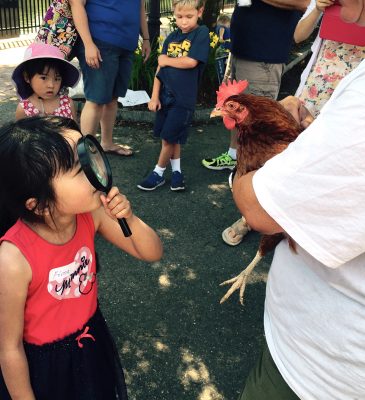
Summer planting starts a little early at CMNH with two “Anyone Can Grow Food” programs on Saturday, June 4. At 10:15am guests will gather to help plant the vegetable and herb garden and learn how to take care of their own plants. Pet Henrietta the chicken and then go home with a pack of seeds, or stick around for another program at 11:45am when visitors will learn how to create a potato tower! Did you know that if you have 6 hours of sunlight and just a 2-foot circle you can plant potatoes that will grow all summer!
To round out the season, come back for the harvest on Saturday, September 24 at 10:15am. Pick a pumpkin, pull up a carrot and dig a potato out of the gardens as staff gets ready to put them to bed for the winter. Kids will learn about composting bins and why worms are so important to keeping gardens healthy. Families will go home with a pumpkin and produce from the garden.
The Anyone Can Grow Food programs are free with Museum admission, but pre-registration is requested to help ensure enough supplies are available for each family. Please call 603-742-2002 to register for these or any programs at the Children’s Museum of New Hampshire.
Reflecting on my Summer Internship at CMNH
It's time to start thinking about summer internships. Read on to hear what this former intern had to say about her internship at the Children's Museum of New Hampshire.
 By: Amanda Girard
By: Amanda Girard
I remember visiting the Children’s Museum in Portsmouth when I was younger. I remember playing in the Yellow Submarine and the fishing boat and creating works of art in what is now known as the Muse Studio. I had a lot of really great memories there.
That younger version of myself could’ve never imagined that one day I would return here as an intern and spend a summer here. Yet, here I am on both the last day of my internship and my 20th birthday!
I have really enjoyed my time at CMNH and I have successfully completed so many projects that I am proud of. I am going to college for a degree in Professional Writing with a minor in Marketing and I really have combined the two in this internship with the Marketing department.
I had a few projects that spanned the length of my entire internship (From Mid-May to the beginning of August). I wrote biographies for all of the over 50 Makers who will be part of the 2015Dover Mini Maker Faire. I had never even heard of Maker Faire until I started to work here and I think it’s just an amazing idea that will only grow as time goes on. As I was writing the biographies, I would always get excited and wound up wishing that I could be around when it happens, as I will be studying abroad in Dublin at the time. Nevertheless, I am proud that I could be a part of getting people excited for Maker Faire this year!
I also worked for a majority of the summer interviewing office staff, museum educators, and volunteers for “Meet the Staff” blog posts for this blog. I enjoyed this project a lot because I got to meet many of the wonderful staff at the Children’s Museum. Everyone here is so kind and friendly and just a lot of fun! I got to experience what it is like to work in an office setting and I saw first-hand how a group of people with many different talents can come together for a common goal: in this case, to provide an amazing experience for children and their families.
Speaking of children and their families, I got to read what they thought of CMNH firsthand with another one of my ongoing projects. One of the first things that I did in the mornings when I arrived for work was check to see if there were any new visitor surveys. I gathered almost 40 surveys over the course of the summer and compiled them. Some outcomes of this were a tally of visitor’s favorite exhibits (with the Yellow Submarine at the top of the list!) and two blog posts about what the Museum offers to older kids and how our exhibits help toddlers learn through repetition.
Other things that I accomplished during my time here include writing tweets and Facebook posts (some things that I had never really tried before!), covering events like Group Visits and the Teddy Bear Clinic and Picnic, crafting emails, tracking visitor zip codes and writing press releases for Museum events and classes.
So what have I learned from doing all of this? Well, I’ve learned another way that I can use my writing in the future and I’ve learned the basics of marketing and social media outreach. I’ve learned about the amount of research that goes into marketing a company and a brand and I’ve learned that I actually really love doing that research! I have also learned what it’s like to work in an office and how to coordinate and work together to accomplish a goal.
But the biggest thing I think I’ve learned, that I already sort of knew, was that I really like working with children and seeing their reactions of joy and excitement when they see the finished product of something we have all worked so hard to create for them. I think that that is an interest that I would really like to pursue further and I’m not sure where that will lead me. But interning at CMNH this summer solidified that the interest is there and who knows where that will lead me in the future!
I am extremely thankful for the opportunity and experience that I have had at the Children’s Museum of New Hampshire this summer and for every amazing person that I have gotten the chance to meet in the process!
A MOSAIC of Cultures to be Explored
Gallery 6, the space reserved for art inside the Children’s Museum of New Hampshire, will have a new exhibition opening on March 5 and featuring art from many different cultures. MOSAIC: Exploring Our Multicultural Neighborhood will be paired with a special celebration of cultural exploration on Saturday, March 12, where guests can taste North African cooking, enjoy traditional Bhutan dancing and music, try their hand at Chinese brush painting and take part in a community art project.
The art on view in MOSAIC will include photographs of immigrants and refugees living in New Hampshire taken by Becky Field from her book Different Roots, Common Dreams, which came out in the Fall of 2015. Photographer David Hiley, who traveled to Haiti with a group of Seacoast, NH medical professional volunteers in coordination with the Haitian Health Foundation, will present his series of Haitian “selfies” of children and parents. “My eye was drawn to the tension I saw between wrenching poverty and the vibrancy and dignity of these children,” shared David. “Allowing the children to take selfies captured the curiosity and joy common to children everywhere.” Also on view will be photographs of children from China taken by retired pediatrician Skip Small and a glimpse into the life of a child from Japan curated by Sayaka and Seth Blewitt. Also on view will be selected dolls from the Museum’s collection of dolls from around the world.
The special celebration of MOSAIC promises to be just as diverse as the cultures represented in the art itself. The event will be from 11am-2pm on Saturday, March 12 at the Children’s Museum of New Hampshire in Dover. Guests who come in traditional cultural costumes (super heroes and princess costumes do not apply) will receive half-off their individual admission. From 10:45am-Noon European classically trained chef Patrice Gerard will demonstrate North African cooking and guests can taste his vegetarian tagine with couscous. Becky Field will be on hand to talk about her photography project and her work documenting cultural, ethnic and religious diversity in NH. At 11:30am and 1pm dancers from Bhutan will demonstrate traditional dance and music in the Museum’s Muse Studio. David Hiley will be walking around the Museum taking “selfies” of guests who come dressed in their traditional costumes. Runjuan Huang will demonstrate Chinese brush painting and guests can try their hand at that or help create a community weaving project, which, when completed, will be installed on the exterior of the Children’s Museum. The opening celebration events are free with regular museum admission.
The MOSAIC exhibition will be on view through Tuesday, May 31 and is sponsored by Optima Bank and Trust, the New Hampshire State Council on the Arts and the Fuller Foundation. In addition to the art on view and special celebration event, every two weeks the Museum educators will focus on the cultures of different countries and feature country themed crafts and activities in the Muse Studio. The countries, in order of appearance, will include Tanzania, Peru, Haiti, Iceland, Japan, Pakistan and Canada. At the end of May, art projects and facts about all seven countries will be displayed together in the Muse Studio.
As always, no admission fee is required to view the art in Gallery 6. Regular admission applies for families who wish to also explore the rest of the Museum.
Un MOSAICO de Culturas
Un MOSAICO de Culturas para ser Exploradas en el Museo del Niño de New Hampshire
Galería 6, el espacio reservado para el arte en el Museo del Niño de New Hampshire, tendrá la apertura de una nueva exhibición el 5 de marzo, y presentará el arte de diversas culturas. MOSAICO: Explorando nuestra comunidad Multicultural, simultáneamente llevará a cabo una celebración especial de la exploración cultural, el sábado 12 de marzo, en donde los asistentes podrán degustar la cocina del Norte de África, disfrutar el baile y la música tradicional de Bután, probar sus destrezas con el pincel en la pintura China y formar parte de un proyecto de arte comunitario.
El arte visto en MOSAICO incluirá fotografías de inmigrantes y refugiados que viven en New Hampshire tomadas del libro Raíces Diferentes, Sueños en Común de Becky Field, el cual salió en el otoño del 2015. El fotógrafo David Hiley, quien viajó a Haití con un grupo del litoral, profesionales médicos voluntarios de NH en coordinación con la Fundación Sanitara de Haití, presentarán las series ‘selfies’ de niños y padres Haitianos. “Me llamo la atención lo que vi entre la desgarradora pobreza y la vitalidad y dignidad de esos niños”, “comentó David”. “Permitiendo capturar la curiosidad y alegría en común que todos los niños tenían por todas partes”. Asimismo serán expuestas fotografías de niños de China, tomadas por el pediatra jubilado Skip Small y se vislumbrará la vida de un niño de Japón capturado por Sayaka y Seth Blewitt. También estarán en muestra muñecas de alrededor del mundo seleccionadas de la colección del Museo.
La celebración especial de MOSAICO, promete ser tan diversa como las culturas presentadas en el arte mismo. El evento se llevará a cabo de 11am-2pm el sábado 12 de marzo en el Museo del Niño de New Hampshire en Dover. Los asistentes que vengan en sus trajes típicos (disfraces de superhéroes y princesas no aplican) pagarán la mitad en su admisión individual. De 10:45 am-a mediodía el chef Patrice Gerard capacitado en Europa, hará una demostración de la cocina del Norte de África y los invitados podrán degustar su tajine vegetariana con cuscús. Becky Field estará accesible para hablar de su proyecto fotográfico y su trabajo de documentación cultural, étnico y la diversidad religiosa en NH. A las 11:30am y 1pm bailarines de Bután harán una demostración de su baile y de su música tradicional en el Estudio Muse. David Hiley caminará alrededor del Museo tomando “selfies” a los invitados que vengan vestidos con sus trajes típicos. Runjuan Huang hará una demostración de la pintura China con pincel y los asistentes podrán también intentar hacerlo o ayudar a crear el proyecto comunitario, el cual, una vez completado será colocado en el exterior de Museo del Niño. La apertura de la celebración de los eventos son gratuitos con su admisión regular del museo.
La exhibición MOSAICO estará a la vista hasta el martes, 13 de mayo y es patrocinada por Optima Bank and Trust, el Consejo Estatal de Artes de New Hampshire y la Fundación Fuller. Además de la exposición de arte y la celebración especial, cada dos semanas los educadores del Museo harán manualidades y actividades culturales de diferentes países en el estudio Muse. Los países, en orden de aparición, incluirán Tanzania, Perú, Haití, Islandia, Japón , Pakistán y Canadá. A Finales de mayo, proyectos y situaciones acerca de los 7 países estarán juntos en exhibición en el Estudio Muse.
Storytime: SNOW

by Meredith Lamothe
Hi there! I am the Lead Educator at The Children’s Museum of New Hampshire and also the host of Baby Storytime. I have a Bachelors Degree in Theatre from The University of Southern Maine and a Masters of Library and Information Science with a focus in Children’s Services from Simmons College.
I’m passionate about early literacy and excited to share information with you about our weekly Baby Storytime stories and activities. Join us for the next Baby Storytime which meets every Wednesday in the Museum's Primary Place exhibit at 9:30am.
SNOW
Our theme today is perfect for the kind of weather we're having: SNOW!
Let's start with a rhyme about snowflakes:
Snow, Snow is falling down
Falling down onto the ground
it’s falling over here
And it’s falling over there
It’s falling so much that it’s everywhere!
Now, what could we do in all that snow? I know! We could ride in our little red sleds!
This one is to the tune of “Bumping up and down in my little red wagon”
Slippin’ and Slidin’ in my little red sled
Slippin’ and Slidin’ in my little red sled
Slippin’ and Slidin’ in my little red sled
Won’t you be my darling?
It is snowy and the sled string’s broken
It is snowy and the sled string’s broken
It is snowy and the sled string’s broken
Won’t you be my darling?
It’s easy to fix with a big strong knot
Easy to fix with a big strong knot
Easy to fix with a big strong knot
Won’t you be my darling?
Slippin’ and Slidin’ in my little red sled
Slippin’ and Slidin’ in my little red sled
Slippin’ and Slidin’ in my little red sled
Won’t you be my darling?
And since we sang about slippin’ and slidin’ in sleds, I have to include my favorite bounce song “The Royal Duke of York” who likes marching armies up and down hills! I bet they wish they had sleds…:)
Now let's do another rhyme about snow. It's called “Five Little Snowmen” and we do this one counting on our fingers:
Five little snowmen standing in a row
Each one has a hat and a big red bow
Out came the sun and it shone all day
And one little snowman melted away!
Four little snowmen…
Three little snowmen…
Two little snowmen…
One little snowman standing in the row
He had a hat and a big red bow
Out came the sun and it shone all day
And that little snowman melted away!
Literacy Tip
Our literacy tip is about talking! Talking about books, making predictions and asking questions helps children understand things when they’re learning to read. Comprehension is an important pre-reading and reading skill. Some kids will learn to read and be able to fly through books, but at the end when asked “So, who was the good guy in that story?” They may have no idea, because although they’re reading – the comprehension is missing – and if that’s missing, those kids won’t stay motivated to read.
Asking babies a question or two about a book before you begin to read helps you and them get into that habit. Talking about books with your child gets them ready to read!
Our last song is about what to wear in the snow! It's called “Boots, Parka, Scarf and Hat” and is to the tune of “Head, Shoulders, Knees and Toes”–you can point to where these items of clothing go while singing this song!
Boots, Parka, Scarf and Hat
Scarf and Hat
Boots, Parka, Scarf and Hat
Scarf and Hat
Boots and Parka and Scaaaaaarf and Haaaaaat
Boots, Parka, Scarf and Hat
Scarf and Hat!
Family Literacy Month Kick-Off
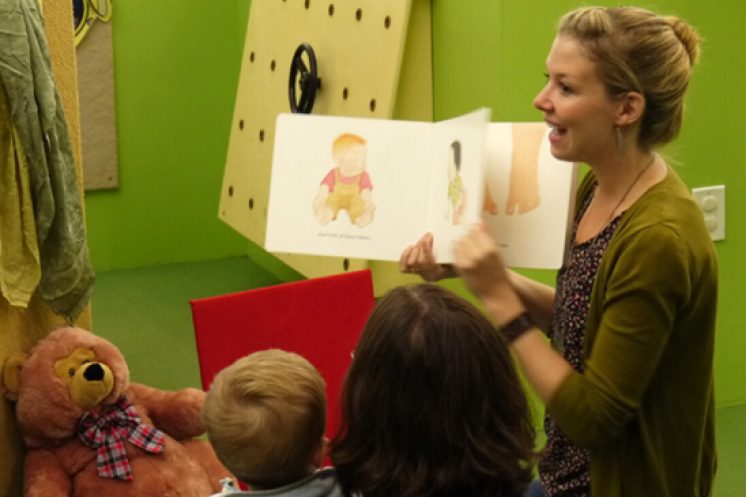
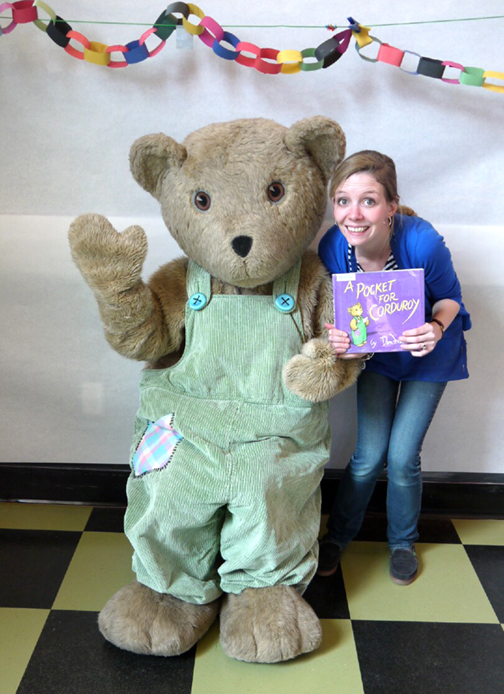 By Meredith Lamothe
By Meredith Lamothe
We’re always excited about literacy here at The Children’s Museum of New Hampshire. Sure, we were thrilled that we were going to celebrate Family Literacy Month this November, but really—we focus on literacy all the time!
We recently hosted a well-attended Jumpstart To Read event; we host Books Alive! events several times a year where costumed characters bring favorite stories to life, and we have weekly Baby Storytimes as part of First Friends Playgroup, where we can teach early literacy skills to the caretakers of our youngest visitors. So a whole month dedicated to literacy? It was a no brainer!
What does family literacy month mean at CMNH?
It means that we’ll have literacy tips posted around that you can peruse as you play. We’ll have multiple activities throughout the week that highlight literacy—and how easy it is to promote and explore at home. We’ve also made up some great handouts, have several guest speakers planned, and will have weekly crafts and games in our Muse Studio—all related to literacy!
We also have our museum. Our museum is a literacy gold mine! Literacy goes so far beyond reading books. Yes, that’s an important part—but literacy, specifically family literacy, is so easy to incorporate into your daily life—or your museum visit!
When you’re playing with your kids in the submarine—make it a story. Does that story have a beginning, middle and end? DING DING DING! LITERACY ALERT! Choose a favorite color when you walk in the museum and then as you play, find that color in each of the exhibits! DING DING DING! Visit the Muse Studio and have your child explain to you the steps they’re taking in making a craft or playing with the magnet table! DING DING DING!
Any conversation, any question, any exploration can easily be made into a rewarding literacy experience. If you have questions, we’re happy to help.
We’re always excited about literacy!
About the Author: Lead Educator Meredith Lamothe has always been a book nerd, library lover and fan of acting out and telling silly stories. She has a blast hosting the Museum’s weekly First Friends Playgroup and has her Master’s Degree in Library and Information Science with a focus in Children’s Programming from Simmons College.
Augmented Reality Sand Table
A New Exhibit Opens at the Children’s Museum of New Hampshire
Children Shape the Landscape with an Augmented Reality Sand Table
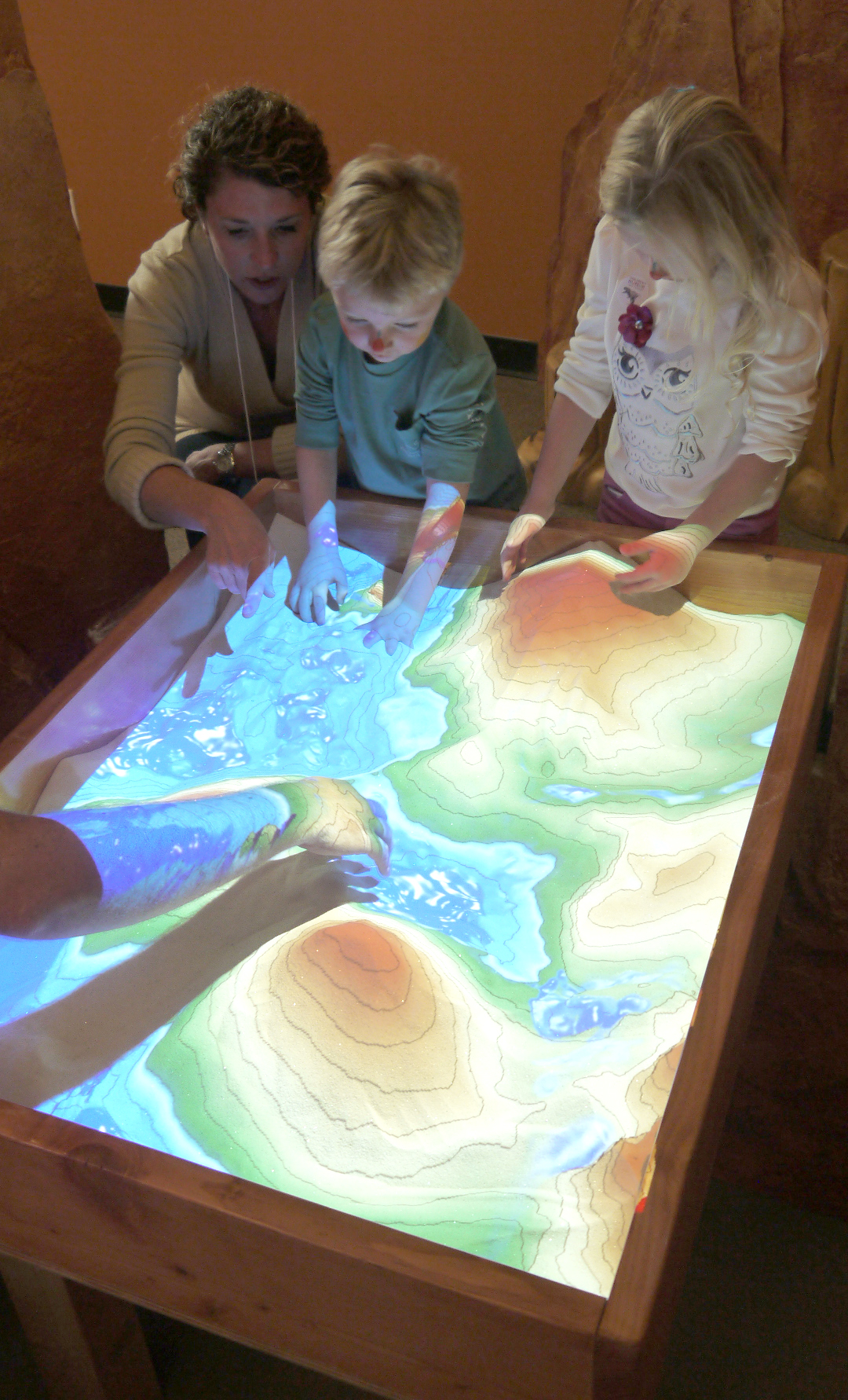 A new exhibit has opened at the Children’s Museum of New Hampshire and it combines all the fun of a sand table, with some interactive and responsive high tech imagery. Guests to the Museum can help shape the landscape with a new augmented reality sand table, installed in the ever-popular Dino Detective area.
A new exhibit has opened at the Children’s Museum of New Hampshire and it combines all the fun of a sand table, with some interactive and responsive high tech imagery. Guests to the Museum can help shape the landscape with a new augmented reality sand table, installed in the ever-popular Dino Detective area.
The technology behind this new exhibit was developed by the UC Davis W.M. Keck Center for Active Visualization in the Earth Sciences (keckCAVES), as part of an informal science education project funded by the National Science Foundation. This hands-on exhibit allows guests to create topography models by shaping real sand, which is then augmented in real time by an elevation color map, topographic contour lines and simulated water, rain and even snow. The system was created to teach geographic, geologic and hydrologic concepts, but the exhibit takes on a different significance when placed in the Museum’s Dino Detective area.
“The sand table relates to the Dino exhibit well,” says Exhibits Director Mark Cuddy. “Geology looks at changes to Earth’s landscape over time, which helps paleontologists determine where to find fossils and, sometimes more importantly, where NOT to look for fossils.” In the rest of the Dino Detective exhibit, guests can dig for fossils, donning the protective eye gear and using the specialized tools that paleontologists would use to unearth these remains. “This entire exhibit is about exploration and questioning what we think we know. Why are the dinosaurs extinct? What can we learn from their bones? How does the water flow around the sand? What happens when I build a dam and then break the dam? Where does the water go?” These kinds of questions are answered, not through labels on a wall, but by the constantly shifting interactivity between the augmented reality component, the sand and the children.
“The best part about this exhibit is that it appeals to everyone. Young, old, new or repeat visitors: Everyone loves to play with the sand!” says Mark. “I’ve heard some great things while watching guests at the table. Things like ‘Woah! Look I made it rain!’ or ‘Let’s all push the sand into a big mountain in the middle of a lake.’ It keeps our guests constantly engaged and learning.”
The Wacky Scientist Reflects on his Career
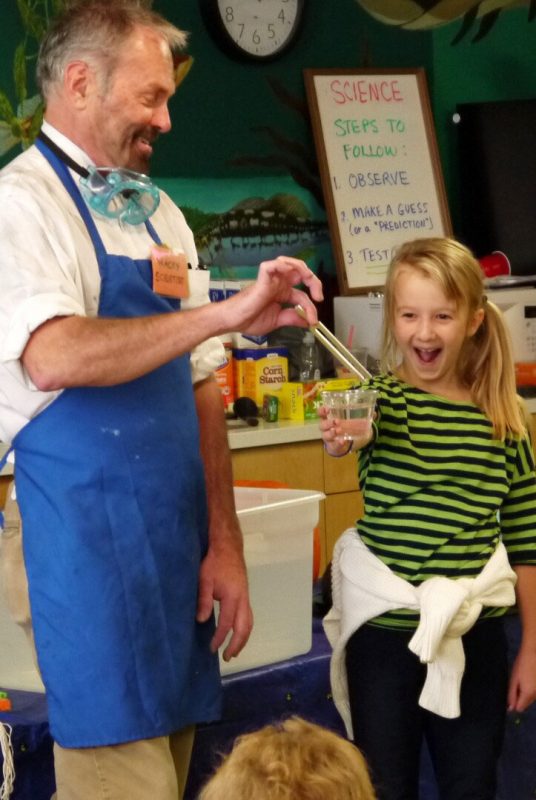
By Doug Tilton
I have had the honor of being the “Wacky Scientist” for the Children’s Museum of New Hampshire for about 14 years now and I spend all year preparing for and looking forward to the October Not-So-Spooky Spectacular! I’m actually the second “Wacky Scientist” to hold this position. The first Wacky Scientist was a former employee named Bill Stroup. He and Jane, our current President, came up with the slightly misleading moniker of “Wacky Scientist.” I’ve never thought of myself as particularly “wacky” (but I suppose I have my moments). In my pre-wacky days I actually did a lot of theatre and directing, which I think has served me well when trying to keep my young audience attentive and entertained.
I had presented science concepts to children’s audiences for years and directed others to do it, but still, the first time I did it as the Wacky Scientist was still a new experience. I relied on my fellow educators to help develop the science experiments that have become a signature highlight of our Halloween celebrations. Then as time went on, I started creating my own experiments and made sure that each show was different and unique!
A few of my favorite experiments over the years have included anti-gravity in a jar, “sink or float,” giant gyroscope, Coke and Mentos explosion and screaming balloons! Of course there are always unexpected surprises. Sometimes those surprises come in the form of costumed kids who want to talk to their friends through my experiments, or perhaps think they already know all about what I’m doing. THEY are the ones I make into my first assistants! Hey, every Wacky Scientist needs a Wacky Assistant. It’s in the bi-laws.
Of course, being a Wacky Scientist, or a Wacky Assistant, isn’t all fun and games. Occasionally it requires some serious dedication and risk taking. One year I was working the kinks out of a fantastic experiment where I used a bungee cord to drop a raw egg from the ceiling onto my assistant’s face! We carefully measured everything to make sure that the bungee would stop the egg from hitting his face at the very last second. Let’s just say, the Wacky Assistant’s dedication was tested that day, as were my Wacky nerves. But in the end, we measured correctly and didn’t end up with any egg on our face, literally or idiomatically.
Are you bringing your wacky kids to this year’s Not-So-Spooky Spectacular?
